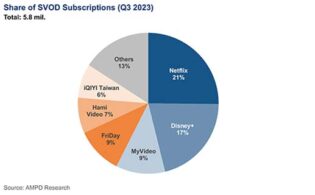The AVIA OTT Summit in Singapore today opened with a comprehensive presentation on the evolving dynamics in Asia’s online video sector and the battle for screen engagement by Media Partners Asia’s Dhivya T.
The lead analyst and head of content and platform insights at Media Partners Asia highlighted research from the company’s AMPD Research division on where premium video sits in the battle for Asian consumers’ time.
“VOD platforms, premium and not, are competing for the same screen time as social media giants, UGC, social video, gaming and music streaming,” she said. “Ultimately, it’s about growing this share of time to lead to better monetization, whether it’s through subscriber acquisition or a share of advertising.”
Consumers are spending more time online, with significant growth in markets like Indonesia and Thailand, which are mobile-heavy territories, she noted. TikTok and social media platforms have seen major gains in Southeast Asia. And while premium VOD does have a slice of online time, “it’s becoming a challenge and an opportunity to keep up with the increases in engagement and drive that increase. Currently social media and TikTok are leading the way.”
Premium VOD does have the highest share in territories such as Japan, Korea and Taiwan and will hit double digits in India this year, she noted. “In all of these markets there is at least one leading local player that is driving up premium VOD reach with local broadcaster content.”
Among consumers that are paying for premium video content, 80 to 90 percent of their screen time is being spent outside of that ecosystem, she noted. “This again is an opportunity for premium VOD to get into the spaces where their users are to market, to build their brands, to follow the consumers into other areas of their digital lives.”
The competitive environment and shift toward a profitability mindset versus one focused purely on subs growth is leading to new models, T continued. With the U.S. platforms adding ad-supported tiers, “we’re seeing a little bit of that come through in Asia,” she said, “especially in higher CPM, more mature markets like Japan, Korea and Australia.”
Other strategies taking shape include the addition of gaming, as Netflix has done, e-commerce, bundles such as Disney+ and Hulu Japan and content licensing partnerships. Consolidation is also expected, with U-Next in Japan having already acquired Paravi in Japan and speculation about a merger between TVING and Waave in Korea. “We’re seeing a new wave of different strategies to monetize beyond the traditional SVOD and AVOD pillars.” Streamers are also increasing prices as they look to drive ARPUs.
Ex-China, online video revenues in AsiaPac are expected to hit $46 billion in 2028, up from $29 billion this year. While SVOD is expected to have a CAGR of 6.4 percent, premium AVOD will see a growth rate of almost 18 percent, led by Australia and Japan as well as Indonesia.
In terms of content investments, pay TV remains the largest vertical, she said, but online is leading growth across the region. “Over the past four years, online video’s share has tripled from 11 percent to a projected 33 percent this year.” Netflix and Prime Video are among those leading the charge in India, alongside Jio Cinema. Netflix and Viu dominate when it comes to Korean content, plus local player TVING. In Southeast Asia, Netflix and Prime Video are key investors, alongside local players like Vidio and Viu.
Local content is key in terms of viewership share, notably in Japan (69 percent, followed by Korean shows at 18 percent and American at 9 percent) and Korea (79 percent, with American content at 8 percent and Japanese at 7 percent). Meanwhile, in Southeast Asia, Korean content is out front at 38 percent, with U.S. content at 21 percent, Japan and local at 12 percent each and Chinese content at 10 percent.
The presentation also highlighted the importance of local content when it comes to subscriber acquisition. “In every market, we find that demand for local content always over-indexes among new users. Local content punches above its weight when it comes to bringing in new users to a platform.”






